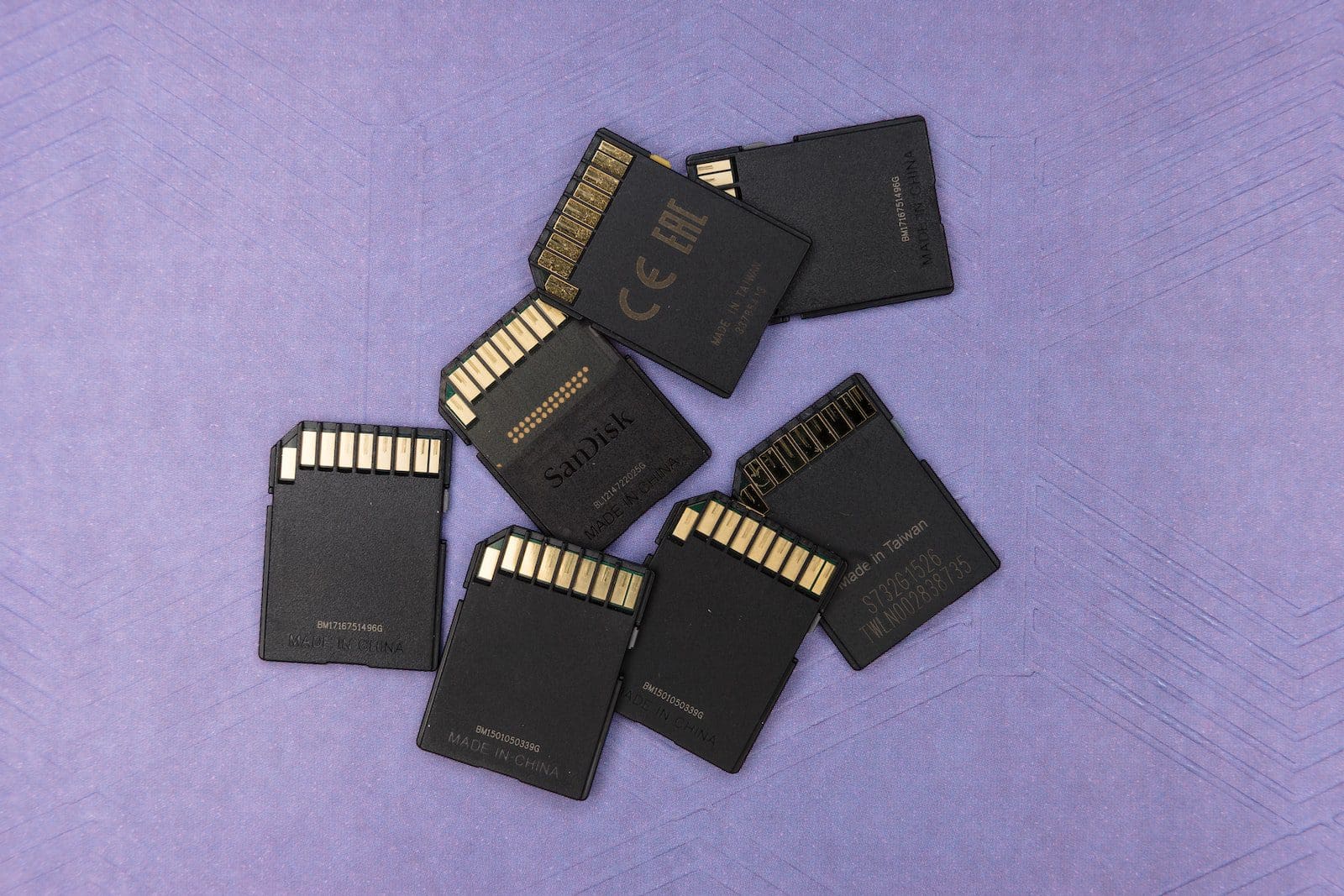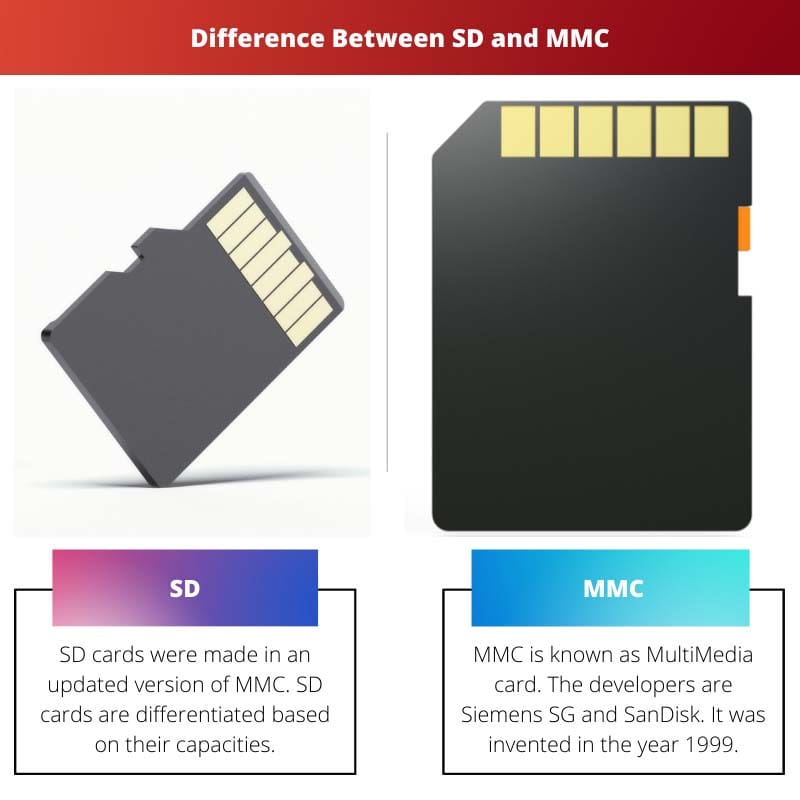SD and MMC are used for storage in a portable device. They are available in various sizes.
SD stands for Secure Digital, whereas MMC stands for MultiMediaCard. They have their characteristics and differ from each other.
A non-volatile memory format is in SD.
Key Takeaways
- SD (Secure Digital) and MMC (Multimedia Card) are types of memory cards used in electronic devices.
- SD cards are larger in capacity and faster than MMC cards.
- While both cards can be used for storage and data transfer, SD cards are more commonly used in cameras and other multimedia devices, while MMC cards are used in smaller devices like mobile phones.
SD vs MMC
SD (Secure Digital) is a memory card that is used to store data. It can also be used to transfer data. An SD card can transfer data at a rate of 20MB per second. It provides a storage capacity of 4TB. MMC (Multimedia Card) can transfer data at a rate of 8MB per second. Its storage capacity is 32MB. It is used in digital cameras.

SD’s full form is Secure Digital. SanDisk, Toshiba, and Panasonic made SD together.
This is only used in digital cameras and music players. It has various storage differences.
It ranges from 152 MB to 2 GB. It is also found in high capacity, which is available for 4GB to 32 GB
The latest version now allows up to 2TB.
MMC’s full form is MultiMediaCard. It is a memory card.
Siemens SG and SanDisk developed the MMC together. Toshiba’s NAND-based flash memory inspired to make MMC.
It can store from 152MB to 32GB. The length of the card is 24mm, the breadth is 32mm, and the height is 1.4mm.
Comparison Table
| Parameters of Comparison | SD | MMC |
|---|---|---|
| Full-Form | Secure Digital | MultiMedia Card |
| Developers | SanDisk, Toshiba and Panasonic | SanDisk and Siemens |
| Storage | 4TB | 32MB |
| Dimensions | 32.0mm x 24.0mm x 2.1mm | 24.0mm x 32.0mm x 1.4mm |
| Types | miniSD, microSD | RS-MMC, MMC PLUS, metal extender |
| Usage | Mobile phone | Digital Camera |
What is SD?
SD cards were made in an updated version of MMC. SD cards are differentiated based on their capacities.
It ranges from 152 MB to 2 GB. High-capacity SD cards can hold data from 4GB to 32 GB.
These high-capacity SD cards are known as SDHC. The latest version is known as the Extended Capacity SD card.
It can hold data up to 2TB. It is a non-volatile card.
It gets invested in 1999.
It is found in three different sizes. They are SD, miniSD, and microSD.
SD has SPI bus mode. The microcontrollers in the SD card use this bus.
A 3.3-volt interface is used in that SD card. It does not need any host license.
There are many transfer modes available on SD cards.
The one-bit SD bus mode has a transfer format and separates commands and the various data channels. There are 9 pins inside the SD card.
The four-bit SD bus mode has reassigned pins that use four data lines to transfer data faster. Host devices are applicable to send 48-bit commands.
A host device is capable of determining memory capacity, typing, and writing to flash memory. It also determines the capabilities of the SD card.

What is MMC?
MMC is known as a MultiMedia card. The developers are Siemens SG and SanDisk.
It was invented in the year 1999. The dimensions of the card are 24mm x32mm x 1.4mm.
It transfers the data at the rate of 20MB per second. It can store data up to 512 MB.
It uses a 1-bit serial interface.
With digitalization, it has been upgraded, and now it is capable enough to transfer 4 or 8 bits per second. These are used in all kinds of digital devices.
There are four types of MMC available in the market.
They are MMC, RS-MMC, MMC PLUS, and metal extenders. There are many more types that were later introduced in the market.
It has to be put into a mechanical adapter.
It can store data of about 2GB. Nokia used RS-MMC in their 770 internet tablet and generation 65.
Later, when Nokia switched to microSD, the RS-MMC was dropped out.
These were no longer in use. MMC can store enough of 32MB.
It has a transfer rate of up to 8MB per second. SanDisk and Siemens joined together in the making of the card.
The range is from 152MB to 32GB. RS-MMC is found in very small sizes.
It is half of the size of MMC.

Main Differences Between SD and MMC
- The full form of SD is Secure Digital, but the full form of MMC is MultiMediaCard.
- SD was built by SanDisk, Toshiba, and Panasonic, but SanDisk and Siemens built MMC.
- The SD card can keep up to 4TB of data, but MMC can hold up to 32 MB.
- The dimensions for an SD card are 32.0mmx24.0mmx2.1mm, but for MMC is 24.0mmx32.0mmx1.4mm.
- SD can be found in SD, miniSD, and microSD, whereas MMC can be found in MMC, RS-MMC, MMC PLUS, and metal extenders.
- SD card is used in mobile phones, whereas MMC is used in digital cameras.


SD was built by SanDisk, Toshiba, and Panasonic, while MMC was built by SanDisk and Siemens. SD cards can transfer data at a rate of 20MB per second and have a storage capacity of up to 4TB. MMC cards have a transfer rate of 8MB per second and a storage capacity of 32MB.
Nokia used RS-MMC in their 770 internet tablet and generation 65.
RS-MMC cards are half the size of MMC cards.
SD cards have different sizes: SD, miniSD, and microSD. They can hold data up to 2TB. MMC cards, on the other hand, have a transfer rate of up to 8MB per second and a storage range from 152MB to 32GB.
RS-MMC cards were no longer in use when Nokia switched to microSD.
N/A
SD cards can hold data from 152MB to 2TB and are commonly used in digital cameras and music players. They use the SPI bus mode and have a 3.3-volt interface. On the other hand, MMC cards have to be put into a mechanical adapter and can store data of about 32MB.
Nokia used RS-MMC in their 770 internet tablet and generation 65.
MMC cards have four types available in the market: MMC, RS-MMC, MMC PLUS, and metal extenders.
SD stands for Secure Digital and MMC stands for Multimedia Card. SD cards are larger in capacity and faster than MMC cards. Both can be used for storage and data transfer, but SD cards are more commonly used in cameras and other multimedia devices, while MMC cards are used in smaller devices like mobile phones.
MMC cards use a 1-bit serial interface and have a transfer rate of up to 8MB per second. They can store up to 32GB of data.
The latest version of SD cards allows up to 2TB storage and uses a 3.3-volt interface.
SD cards are available in various sizes and can hold data up to 2TB. They are commonly used in cameras and music players. On the other hand, MMC cards can store data from 152MB to 32GB and are half the size of SD cards.
The range of MMC is from 152MB to 32GB.
MMC has a transfer rate of up to 8MB per second.
SD cards are available in three different sizes and can hold data up to 2TB. MMC cards can store data from 152MB to 32GB and have a transfer rate of up to 8MB per second.
RS-MMC is half the size of MMC.
N/A
SD cards have a storage capacity of up to 4TB and can transfer data at a rate of 20MB per second. MMC cards, on the other hand, have a storage capacity of 32MB and can transfer data at a rate of 8MB per second.
The developers of SD are SanDisk, Toshiba, and Panasonic.
SD cards have three different sizes: SD, miniSD, and microSD. They use SPI bus mode and have a 3.3-volt interface. On the other hand, MMC cards have to be put into a mechanical adapter and can store data up to 32GB.
MMC has four types available in the market: MMC, RS-MMC, MMC PLUS, and metal extenders.